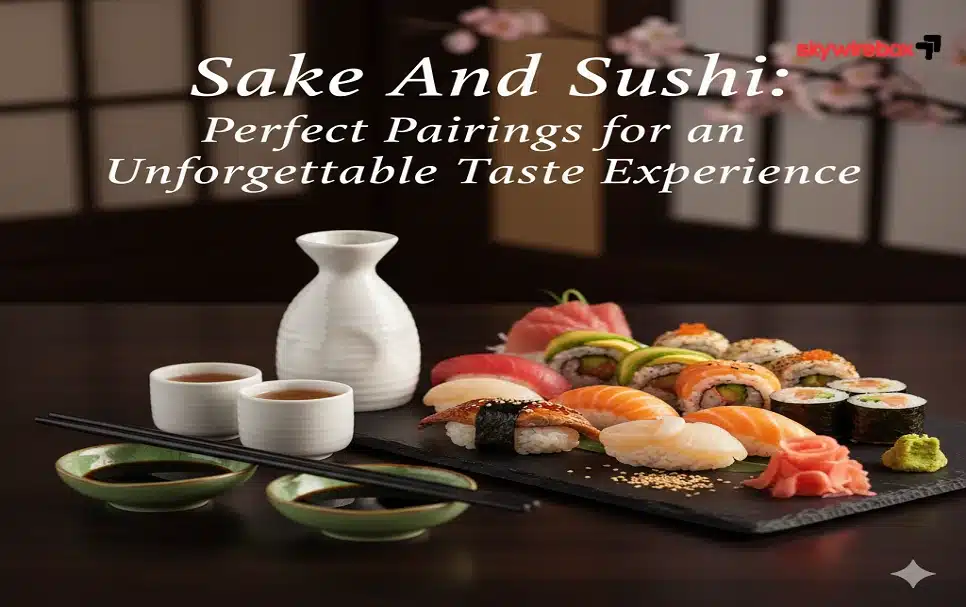If you’re curious about Sake And Sushi it fits into your lifestyle, you’re in the right place. Sake isn’t just a drink; it’s an experience that connects you to centuries of Japanese tradition.
Whether you’re new to sake or looking to deepen your appreciation, understanding its flavors, varieties, and perfect pairings can change the way you enjoy this unique rice wine. Ready to discover how sake can elevate your next meal or social gathering?
Keep reading, and you’ll learn everything you need to enjoy sake like a pro.
Sake Origins
Sake is made by fermenting polished rice. The rice is cleaned to remove the outer layers. This helps create a clear and smooth taste. Special mold called kōji- kinbreaks down rice starch into sugars. Yeast then ferments these sugars into alcohol. The process can take several weeks.
There are many types of sake. Some are light and fruity, others are rich and full-bodied. Jun mais pure rice sake with no added alcohol. Daiginjois high-quality sake made from very polished rice.
| Region | Flavor Notes | Special Traits |
|---|---|---|
| Niigata | Clean, crisp | Cold winters help slow fermentation |
| Kyoto | Rich, mellow | Soft water used in brewing |
| Hiroshima | Light, dry | Uses hard water, making dry sake |
Sushi Essentials
Sushi comes in many varieties that everyone can enjoy. Popular types include nigiri(fish on rice), maki (rolls with seaweed), and sashimi(just slices of raw fish). Each has a unique flavor profile. For example, nigiri tastes fresh and mild, while maki offers a mix of textures and flavors.
Ingredients play a big role in sushi’s taste. Fresh fishlike tuna or salmon is key. The rice is seasoned with vinegar, sugar, and salt, giving a slightly sweet and tangy flavor. Seaweed wraps add a salty and umami taste. Wasabi and soy sauce add spice and saltiness, making the sushi more exciting.
Flavor Pairing Basics
Balancing taste and texture is key to pairing sake well. Sake has a smooth, light texture that can match soft or firm foods. It works best with dishes that are not too heavy or oily. The sweetness or dryness of sake should balance the food’s flavors, not overpower them.
Complementary flavors enhance the sake experience. Fruity or floral sake pairs well with delicate flavors like fish or light vegetables. Richer sake with umami suits grilled or savory dishes. Matching the intensity of sake and food creates harmony on the palate.
Avoiding clashes helps prevent unpleasant tastes. Avoid pairing very strong or spicy foods with mild sake. Sour or bitter foods can conflict with sake’s subtle sweetness. Careful pairing ensures the sake and food bring out the best in each other.
Sake And Sushi Pairings
Light sake matches well with delicate sushi like white fish and simple rolls. Its gentle flavor does not overpower the freshness of the sushi. This pairing lets you enjoy the subtle tastes of both sake and sushi.
Rich sake suits bold sushi rolls with strong flavors like eel or spicy tuna. The deep taste of rich sake balances the intensity of these rolls. It also adds warmth and depth to the meal.
Nigori sakeis creamy and slightly sweet. It pairs best with spicy dishes such as spicy salmon or wasabi rolls. The sweetness of nigori softens the heat, creating a smooth taste experience.
Serving Tips
Optimal sake temperature varies with the type of sake. Serve cold sake around 5-10°C for fresh flavors. Warm sake, about 40-50°C, brings out richer tastes. Avoid overheating to keep delicate aromas intact.
Sushi presentation ideas enhance the meal visually. Use colorful garnishes like thinly sliced cucumber or pickled ginger. Arrange sushi on a wooden platter or a simple white plate for contrast. Small bowls with soy sauce add elegance.
Enhancing the dining experience involves creating a calm atmosphere. Soft lighting and clean table settings help. Pair sake with light bites such as edamame or tempura. Sip slowly to enjoy the flavors fully.
Popular Sake Brands
Affordable sake brandslike Sho Chiku Bai and Hakutsuru offer good taste without high cost. Sho Chiku Bai Nigori Sake is around $8.49, while Hakutsuru Sayuri Nigori Sake costs about $15.49. These options are great for beginners or casual drinkers. They bring the essence of sake to any meal or occasion.
Premium sake picks include brands like Konteki Tears of Dawn Daiginjo and Suigei Drunken Whale Tokubetsu Junmai. These bottles range from $30 to $45. They have refined flavors and smooth finishes. Enjoying premium sake gives a special experience for those who want more depth.
| Store | Brand | Price | Availability |
|---|---|---|---|
| H-E-B | Sho Chiku Bai Nigori | $8.49 | In stock |
| Total Wine & More | Hakutsuru Sayuri Nigori | $15.49 | In stock |
| Travis Heights Wine & Spirits | Suigei Drunken Whale | $15.99 | In stock |
| CB2 | Premium Sake | $44.95 | In stock |
Many of these sake brands are easy to find in Austin, Texas. Local liquor stores and larger chains carry a good variety. Exploring these stores can lead to discovering your favorite sake type.

Sake Tasting Guide
To taste sake, first look at its color. It should be clear or slightly yellow. Next, smell the sake gently. Try to find fruity or floral aromas. Take a small sip and let it rest on your tongue. Notice if it feels sweet, dry, or smooth. Try to detect any umami or earthy flavors.
Common flavor notes include melon, banana, rice, and nutty hints. Each sake has its own unique taste.
Pair sake with dishes like sushi, grilled chicken, or light salads. Lighter sake matches well with seafood. Richer sake goes great with fried or spicy foods. Experiment to find your favorite combination.
Cultural Insights
Sake plays a special role in Japanese tradition. It is often served at ceremonies and festivals. People believe sake brings good luck and cleanses the spirit. It is also shared during celebrations to strengthen bonds among friends and family.
When enjoying sushi, etiquette is important. Sake is sipped slowly to complement the flavors of the fish. It is polite to hold the cup with both hands when receiving sake. Avoid pouring sake for yourself; offer it to others first.
Modern trends pair sake with many foods beyond sushi. It goes well with grilled meats, cheese, and even desserts. Sake’s taste varies from sweet to dry, allowing diverse food matches. Many people now enjoy chilled sake, which highlights its fresh and fruity notes.
Frequently Asked Questions
What Do You Drink Sake With?
Pair sake with sushi, sashimi, tempura, grilled fish, or light appetizers. It complements mild and umami flavors well.
What Is A Good Mix With Sake?
A good mix with sake includes citrus juices like yuzu or lemon, ginger, soda water, or light fruit flavors such as pear or apple. These enhance sake’s delicate taste without overpowering it.
What’s Good To Eat With Sake?
Sake pairs well with Sake And Sushi, sashimi, grilled seafood, tempura, and light appetizers. Its subtle flavors complement delicate dishes perfectly.
Do Vodka And Sake Go Together?
Vodka and sake have different flavors but can mix well in cocktails. Combining them creates unique, smooth taste profiles.
Conclusion
Sake offers a unique taste of Japanese culture and tradition. It pairs well with many foods, especially yakitori. Exploring different types of sake can be a fun experience. Enjoying sake in Austin, Texas, brings a touch of Japan closer to home.
Whether new or experienced, sake invites you to savor every sip. Give it a try and discover its rich flavors today. Our all updete get to visit our website: skywirebox







